

Flash photography tip: Find your background, then your settings - Tangents. With flash photography on location, we nearly always start off by figuring out what we want to do in relation to our available light.
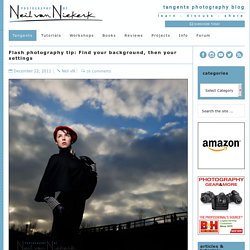
We might just need fill-flash, or or flash might need to do the “heavy lifting” and expose correctly for our subject in relation to the available light. When we have our subject in (relative) shade, and need to figure out our flash exposure, we also need to decide exactly what our background is. It usually works best to be specific about our background … and how we position ourselves and our subject in relation to that. So let’s run through that thought-process, using the image at the top. Fotograferen met een flitser - deel 1 - nandoonline fotografie blog. Met de hand flitsen en instellen (manueel flitsen) - Hennuin Fotografie Utrecht. Five Classic Lighting Recipes. 5.

Cross Lighting If someone asked me what lighting technique I use the most, I’d reply cross lighting. This lighting technique uses two light sources opposite one another with your subject in the middle. One light will be illuminating your subject’s front, while the second light will be an accent light illuminating his shoulder, hair or backside. Any combination of softboxes, reflectors and umbrellas can be used. 6 Portrait Lighting Patterns Every Photographer Should Know. In classical portraiture there are several things you need to control and think about to make a flattering portrait of your subjects, including: lighting ratio, lighting pattern, facial view, and angle of view.

I suggest you get to know these basics inside out, and as with most things, then you can break the rules. But if you can nail this one thing you’ll be well on your way to great people photos. How to Use Short and Broad Lighting in Portrait Photography. If you are into portrait photography, you know you can light your subject in many different ways.

But have you heard of short and broad lighting? In this article, I will give you a short introduction to the use of short and broad lighting styles. What Does Broad and Short Light Mean When it comes to face lighting, people tend to consider broad and short light as photography lighting setups. 6 Portraits – shaping with the studio light. When you start doing portraits, the general advice is to learn to position the light.
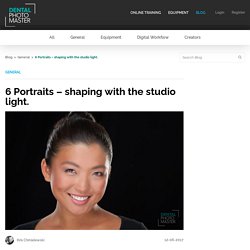
Depending on the lighting equipment you can get different images. The result will be influenced by the light quality, quantity, color, and direction. For the purpose of this article I am focused only on light position, a number of the light sources and additional light modifiers like softboxes and reflectors. Studio lighting: 4 seriously simple lighting techniques to try at home. Studio lighting can seem daunting if you’ve never tried it before.
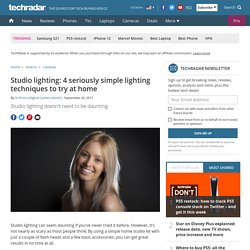
However, it’s not nearly as scary as most people think. By using a simple home studio kit with just a couple of flash heads and a few basic accessories, you can get great results in no time at all. This is What Different Light Modifiers Do for Studio Portraits. Starting out in studio portraiture and not sure what light modifier to choose to achieve the photo you want?
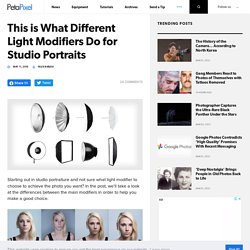
In the post, we’ll take a look at the differences between the main modifiers in order to help you make a good choice. Beauty bowl, softbox, stripbox, reflector bowl, umbrella of all kinds and sizes, flash ring, etc… It is a bit like choosing a new car — there are many choices, but which one matches your expectations? This is what each of the lights do on a studio portrait set. Using flash - Essential ideas, tips and techniques to transform your portrait photography. 3.
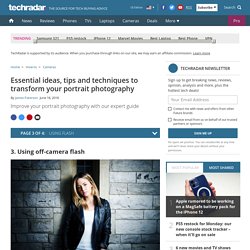
Using off-camera flash When you shoot portraits purely with natural light, you're usually restricted to one 'correct' exposure. But when you start to mix natural light with flash, then you can manipulate the exposure to suit your artistic means. Any time that you work with two different light sources, the key is all about the ratio between the two. You can't control the power of the sun, for example, but you can change your speedlight power to alter the ratio between the two – as we've shown here by overpowering the midday sun for a dramatic moody portrait.
Controlling bright daylight with direct off-camera flash - Tangents. Working with Molly K as our model during an personal photography workshop in New York, we put into action the thought-process when using flash in very bright light.
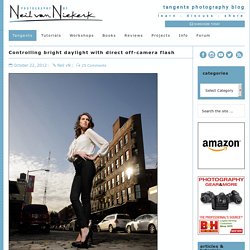
There’s a specific algorithm that gets us to optimal settings. But, as usual, there’s more to a final image than just the numerical settings on the camera … Camera settings and decisions When trying to over-power the sun with flash, the best algorithm is usually: – maximum flash sync speed, – lowest ISO, – find the aperture for your brightest area that you want to expose correctly for, at that specific shutter speed and ISO. Underexposure with Flash. 5 Ways to Use a Beauty Dish. Photographer and Profoto Legend of Light Miguel Quiles made this 7-minute video in which he shares 5 different ways he likes to use a beauty dish for portrait lighting.
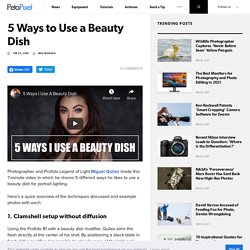
Here’s a quick overview of the techniques discussed and example photos with each. 1. 6 Portraits – shaping with the studio light. The size and placement of studio lights - Tangents. Mateos, a model & fitness trainer, in the studio. More than just a fitness photograph (via dramatic light to show off his physique), I wanted these to be portraits as well of this athlete.
With fitness photography, the approach is usually to have photos where you show detail and contouring. Church Sound, Video and Lighting Systems. Hard en zacht licht. How To "Read" Light In Photography - Part 1. One of the first very important skills I acquired in my Australian Photography course was the ability to breakdown lighting and determine approximate camera settings in images taken by other photographers. If you understand how the direction of light and its degree of diffusion are controlled and how they affect images, it should be easy for you to train yourself to "read" lighting in the images you see in magazines, on billboards and in your favorite photographers’ portfolios. It's like speaking a secret language. It's fun and very helpful for your ability to set and control lighting in your own photos. In other words, it will be easier for you to successfully select your camera settings and set up correct lighting to get what you envisioned to achieve, or what your client is asking you for.
How to Do a High-Key Portrait. Photographer Oleg Ti knows light. He also knows how to share that knowledge. In this post he’ll use the D1 monolight to show us how to do a high-key portrait. 6 Best + Free Portrait Photography Courses & Classes [2021 JANUARY] [UPDATED] Photography Experiment: Six Photographers, One Portrait, And A Twist. Photography is a very personal matter. Not only for the subject but the photographer as well. As photographers, how much can our perceptions shape an image? Can our perspectives skew an image? 11 Best Portrait Photographers to Inspire You. One of the more common types of photography, especially in the digital age of the “selfie“, is portrait photography.
Also known as portraiture, portrait photography is the art of taking a photo of a single person or group of people, capturing their most real mood and emotion. Portrait photography is a constant challenge and requires the photographers creativity in order to really achieve beautiful portraits.